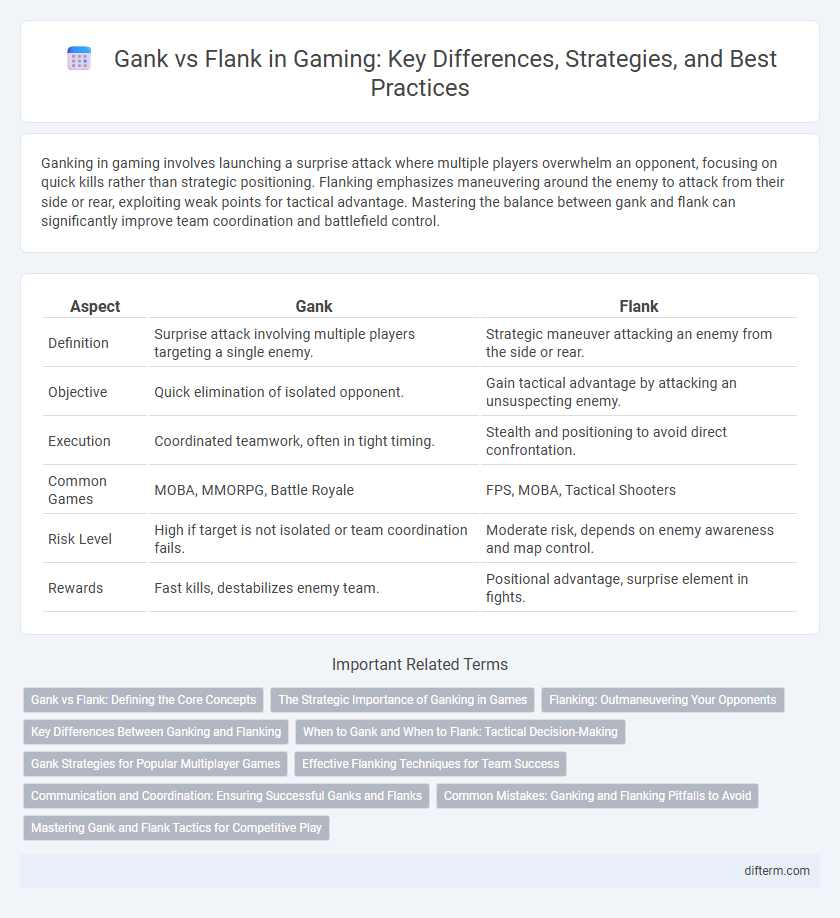Ganking in gaming involves launching a surprise attack where multiple players overwhelm an opponent, focusing on quick kills rather than strategic positioning. Flanking emphasizes maneuvering around the enemy to attack from their side or rear, exploiting weak points for tactical advantage. Mastering the balance between gank and flank can significantly improve team coordination and battlefield control.
Table of Comparison
| Aspect | Gank | Flank |
|---|---|---|
| Definition | Surprise attack involving multiple players targeting a single enemy. | Strategic maneuver attacking an enemy from the side or rear. |
| Objective | Quick elimination of isolated opponent. | Gain tactical advantage by attacking an unsuspecting enemy. |
| Execution | Coordinated teamwork, often in tight timing. | Stealth and positioning to avoid direct confrontation. |
| Common Games | MOBA, MMORPG, Battle Royale | FPS, MOBA, Tactical Shooters |
| Risk Level | High if target is not isolated or team coordination fails. | Moderate risk, depends on enemy awareness and map control. |
| Rewards | Fast kills, destabilizes enemy team. | Positional advantage, surprise element in fights. |
Gank vs Flank: Defining the Core Concepts
Gank involves a sudden, coordinated attack on a single enemy, often catching them off guard to secure a quick kill. Flank refers to maneuvering around the enemy's side or rear to gain a tactical advantage, disrupting their formation and creating opportunities for attacks. Both strategies emphasize positioning and timing but differ in execution and team coordination within competitive gaming.
The Strategic Importance of Ganking in Games
Ganking plays a crucial strategic role in games by allowing players to coordinate surprise attacks that disrupt enemy formations and create numerical advantages. Effective ganking requires precise timing and communication, enabling teams to control key objectives and momentum shifts. Unlike flanking, which focuses on outmaneuvering opponents for positional advantage, ganking emphasizes overwhelming enemies quickly through numbers and element of surprise.
Flanking: Outmaneuvering Your Opponents
Flanking involves strategically positioning yourself to attack enemies from the side or behind, catching them off guard and disrupting their formation. Mastering flanking requires map awareness, timing, and communication to exploit enemy vulnerabilities and create numerical advantages in team fights. Effective flanking can turn the tide of battle by isolating key targets and preventing coordinated enemy responses.
Key Differences Between Ganking and Flanking
Ganking in gaming involves a sudden and overwhelming attack by multiple players on a single target, aiming to secure a quick kill through numerical advantage and element of surprise. Flanking focuses on strategic positioning, where a player or team approaches the enemy from the sides or rear to bypass defenses and create tactical pressure without immediate overwhelming force. The key difference lies in ganking's reliance on teamwork and ambush for rapid elimination, whereas flanking emphasizes maneuverability and positioning to exploit weaknesses in enemy formations.
When to Gank and When to Flank: Tactical Decision-Making
Ganking is most effective when teammates converge on a single enemy in confined spaces or during vulnerable moments, maximizing surprise and overwhelming force. Flanking is optimal for bypassing enemy defenses, attacking from unexpected angles, and disrupting formations without direct confrontation. Tactical decision-making relies on map awareness, enemy positioning, and team coordination to choose ganking for quick eliminations or flanking for strategic pressure.
Gank Strategies for Popular Multiplayer Games
Gank strategies in popular multiplayer games like League of Legends and Dota 2 involve coordinated surprise attacks designed to overwhelm isolated enemies quickly, maximizing kill potential and map control. Effective ganks require precise communication and timing, leveraging champions or heroes with crowd control abilities to secure kills and disrupt enemy positioning. Mastering gank mechanics enhances team dominance by creating pressure across lanes and enabling better objective control, such as securing towers or Roshan.
Effective Flanking Techniques for Team Success
Effective flanking techniques significantly increase a team's chances of success by creating unexpected angles of attack that disrupt enemy formations and reduce their defensive capabilities. Utilizing map awareness, communication, and timing, players can coordinate simultaneous attacks from multiple directions, overwhelming opponents and securing key objectives before they can react. Mastering these strategies enhances overall team synergy, turning flanking maneuvers into decisive moments that shift the momentum of the game.
Communication and Coordination: Ensuring Successful Ganks and Flanks
Effective communication and coordination are crucial for executing successful ganks and flanks in gaming, enabling teammates to synchronize movements and target high-priority enemies efficiently. Clear callouts, real-time updates, and timing precision help reduce the risk of ambush failure and maximize damage output during both gank ambushes and strategic flank maneuvers. Utilizing voice chat or quick communication tools ensures that players adapt dynamically to enemy reactions, maintaining tactical advantage and increasing overall team success.
Common Mistakes: Ganking and Flanking Pitfalls to Avoid
Common mistakes in ganking include poor timing and inadequate vision control, leading to failed ambushes and unnecessary deaths. Flanking errors often stem from predictable routes and lack of communication, exposing flankers to easy counterattacks. Prioritizing map awareness and team coordination significantly reduces these pitfalls in competitive gaming scenarios.
Mastering Gank and Flank Tactics for Competitive Play
Mastering gank tactics involves coordinating surprise attacks on isolated opponents to secure quick kills and disrupt enemy strategies. Effective flank maneuvers require positioning behind or to the side of enemies, exploiting blind spots to gain strategic advantages in team fights. Combining precise timing and map awareness enhances competitive play by maximizing pressure and controlling key objectives.
gank vs flank Infographic

 difterm.com
difterm.com